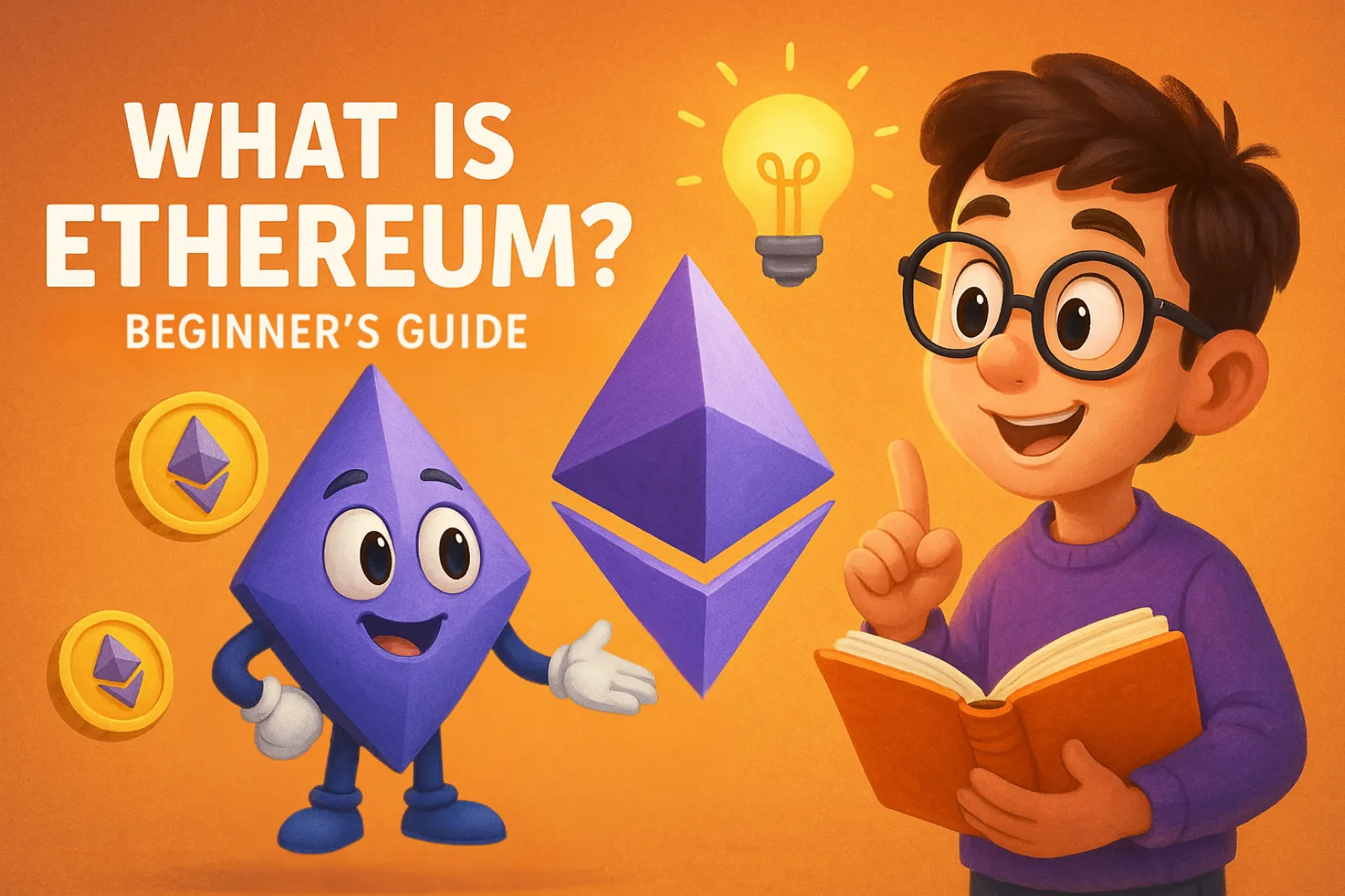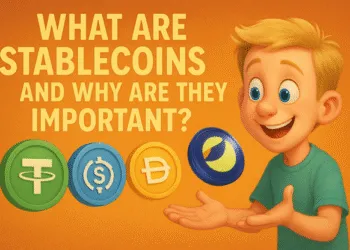You’ve probably heard of Bitcoin — the original cryptocurrency. But Ethereum is something different. While Bitcoin was created to be digital money, Ethereum was built to be something bigger: a platform for building apps, programs, and new types of digital ownership — all without middlemen.
Launched in 2015 by Vitalik Buterin, Ethereum introduced the idea of smart contracts — self-executing pieces of code that run exactly as programmed. This breakthrough allowed developers to build decentralized apps (dApps), sparking the rise of DeFi, NFTs, DAOs, and the entire Web3 movement.
Today, Ethereum is not just the second-largest cryptocurrency by market cap — it’s the backbone of the decentralized internet.
In this beginner-friendly guide, you’ll learn:
- What Ethereum is (and how it’s different from Bitcoin)
- How it works under the hood
- What Ether (ETH) is used for
- Real-world applications and why it matters in 2025
New to crypto? You might want to start with What Is a Cryptocurrency? A Beginner’s Introduction
What Is Ethereum?
Ethereum is a decentralized, open-source blockchain network that enables developers to build and deploy applications that run without centralized control. Unlike Bitcoin, which was designed mainly to serve as a digital currency, Ethereum was created to be a global, programmable platform.
The idea was born in 2013, when Vitalik Buterin, a young developer and Bitcoin enthusiast, published the Ethereum whitepaper. He envisioned a blockchain not just for money, but for smart contracts — bits of code that execute automatically when certain conditions are met.
Ethereum officially launched in 2015, and it introduced a whole new concept to the crypto world: programmable money. That means instead of just sending or receiving coins, users could create decentralized apps (or dApps) for anything from finance to gaming to identity management.
Think of Ethereum as a world computer: a shared infrastructure where code runs transparently and no one can shut it down.
How Does Ethereum Work?
At the core of Ethereum is the idea of smart contracts — self-executing pieces of code that live on the blockchain. They allow people to create rules, apps, and digital agreements that run automatically without the need for a central authority or manual intervention.
For example, you can write a smart contract that says:
“If Alice sends 1 ETH to the contract, then Bob receives a digital ticket.”
Once written and deployed, no one can alter the code — not even the person who created it.
These contracts are powered by the Ethereum Virtual Machine (EVM) — a decentralized global computer that runs the logic of every smart contract and decentralized app (dApp) built on Ethereum.
The Merge: From Proof of Work to Proof of Stake
Originally, Ethereum used Proof of Work (PoW) like Bitcoin. But in 2022, Ethereum transitioned to Proof of Stake (PoS) in a major upgrade called The Merge.
Now, instead of miners using energy to validate transactions, validators stake ETH to help secure the network and earn rewards.
This made Ethereum:
- More energy-efficient (over 99% less energy usage)
- More secure and scalable
- Better aligned with long-term sustainability
Want to learn more about the difference between Proof of Work and Proof of Stake? Read: Proof of Work vs Proof of Stake (Explained Simply)
What Is ETH (Ether)?
While Ethereum is the network, Ether (ETH) is its native cryptocurrency — and it powers everything on it. Think of ETH as the fuel that keeps the Ethereum engine running.
You need ETH to:
- Pay gas fees (transaction costs on the network)
- Interact with smart contracts
- Use decentralized apps (dApps)
- Stake and help secure the network (and earn rewards in return)
So, even though Ethereum is often described as a decentralized computer, it wouldn’t function without ETH. Every time you send a transaction, mint an NFT, or trade on a DeFi app — you pay a small fee in Ether.
Gas Fees: What Are They?
Gas fees are the cost of using the Ethereum network. These fees go to validators who process and secure the transactions.
The amount of gas you pay depends on:
- Network demand (high = more expensive)
- Complexity of the action (simple transfer vs NFT mint)
Gas fees have become a hot topic — Ethereum’s upgrades (and Layer 2 solutions) aim to make them cheaper and faster.
What Is Ethereum Used For?
Ethereum is much more than just a blockchain — it’s an entire ecosystem of apps, tools, and use cases. From decentralized finance to digital art, Ethereum powers a wide range of real-world applications.
Here are some of the most common ways Ethereum is used today:
- DeFi (Decentralized Finance)
Ethereum is home to thousands of DeFi apps that let users borrow, lend, earn interest, and trade crypto — without banks. Platforms like Uniswap, Aave, and MakerDAO run entirely on smart contracts.
- NFTs and Digital Ownership
Non-fungible tokens (NFTs) exploded in popularity thanks to Ethereum. From digital art and music to gaming assets and collectibles, Ethereum enables true digital ownership that can’t be copied or censored.
- DAOs (Decentralized Autonomous Organizations)
These are blockchain-based communities that operate without central leadership. Token holders vote on proposals and manage shared resources — all via smart contracts.
- Web3 & Gaming
Ethereum powers Web3 experiences where users own their identity, data, and in-game assets. From play-to-earn games to metaverse land, Ethereum enables a new internet model.
Ethereum’s ecosystem also includes identity systems, fundraising tools, and even decentralized social media platforms.
Ethereum FAQs
Is Ethereum the same as Bitcoin?
No — while both are cryptocurrencies, they serve different purposes. Bitcoin is designed to be a store of value and digital money, while Ethereum is a programmable platform for building decentralized apps and smart contracts.
Is Ethereum safe to invest in?
Ethereum is one of the most established and actively developed blockchain platforms. However, like all crypto assets, it comes with risks — including price volatility, technical vulnerabilities, and regulatory uncertainty. Always DYOR (do your own research).
What is gas in Ethereum?
Gas refers to the fee you pay to process transactions or run smart contracts on Ethereum. It’s paid in ETH and varies depending on network demand and transaction complexity.
Can I earn passive income with Ethereum?
Yes. With Ethereum now using Proof of Stake, you can earn rewards by staking ETH and helping to secure the network. Staking is one of the most popular ways to generate passive income in crypto.
What is gas in Ethereum?
Gas refers to the fee you pay to process transactions or run smart contracts on Ethereum. It’s paid in ETH and varies depending on network demand and transaction complexity.
Final Thoughts: Why Ethereum Matters in 2025
Ethereum is the foundation of an entirely new internet economy. From DeFi and NFTs to decentralized governance and identity, Ethereum has become the go-to platform for builders, creators, and everyday users who want to take back control from centralized systems.
And with its shift to Proof of Stake, Ethereum is now faster, greener, and more scalable — ready to support the next wave of innovation in Web3.
Whether you’re here to invest, build, or just understand the future of money and the internet, Ethereum is a great place to start.
Keep Learning
- What Is a Cryptocurrency? A Beginner’s Introduction
- What Is Bitcoin? Beginner’s Guide to the First Cryptocurrency (2025)

















